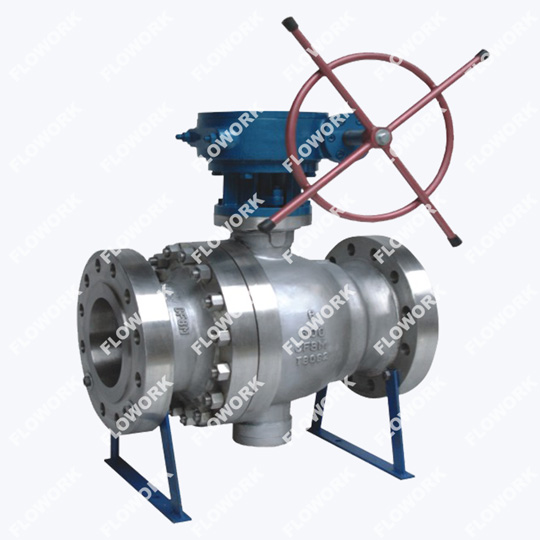
1、You are in restricted area and need password. Please Contact us to obtain documents.
2、PasswordIf you have any questions about quotation or cooperation, please feel free to send us inquiry. Inquiry us
Size:2"-56"Pressure:150LB-2500LBBody Material:CD3MNWCuN, CW2M, Monel, CN7M, 20#Alloys, 4A, 5A, C95800, C95500, etc.Seal Material:PEEK, RPTFE, PTFE, DEVLON, HNBR, NYLON, AFLAS, STELLITE,etc.Connection Type:Flanged, Butt Welded, Socket Welded, NPTOperation:Hand lever, gear operated, pneumatic, motorizedFace to Face Dimension:ASME B16.10Flange End Dimension:ASME B16.5Butt Welded Dimension:ASME B16.25Design and Manufacture:API 6DTest Standard:API 598, API 607, API 6FA, ISO 15848-1-2
Including duplex steel, super duplex steel, inconel, monel and other special steel materials
Sealing material: PTFE, RPTFE, PPL, PEEK, DEVLON, NYLON, etc.
Floating ball type and trunnion mounted ball type; 2-piece and 3-piece structure
End connection type: flanged, bw ends, sw ends, npt ends, fully weld ends
Used for cutting off, distributing and changing the direction of the flow with high corrosion
Suitable for most acidic services and corrosive environments
Gas ball valves should not be used for water applications. Gas ball valves are designed specifically for use with gas and may not be able to withstand the pressure and corrosive properties of water. It is important to use the appropriate valve for the specific application to ensure safety and proper function, ball valve manufacture.
To adjust the stop on a ball valve, follow these steps:
1. Turn off the water supply to the valve. 2. Remove the handle from the valve by loosening the set screw on the side of the handle. 3. Use pliers to remove the nut that holds the valve stem in place. 4. Pull the valve stem out of the valve body. 5. Locate the stop ring on the valve stem. This is a small metal ring that sits on the stem and prevents it from turning too far. 6. Use pliers to adjust the position of the stop ring. Move it up or down the stem to adjust the range of motion of the valve. 7. Reassemble the valve by inserting the stem back into the valve body and tightening the nut that holds it in place. 8. Replace the handle and tighten the set screw.
Once you have adjusted the stop on the ball valve, turn the water supply back on and test the valve to make sure it is working properly, gate valve manufacture.
Mounting large ball valves typically involves the following steps:
1. Ensure that the valve is the correct size and type for the application. 2. Position the valve in the desired location and secure it in place using appropriate mounting hardware. 3. Connect the valve to the piping system using appropriate fittings and gaskets. 4. Tighten all connections to the recommended torque specifications. 5. Test the valve for proper operation and leaks before putting it into service.
It is important to follow the manufacturer's instructions and any applicable industry standards when mounting large ball valves. If you are unsure about any aspect of the installation process, consult with a qualified professional, bronze valve.
When selecting a ball valve, there are several factors to consider:
1. Material: Choose a material that is compatible with the fluid being transported. Common materials include stainless steel, brass, and PVC.
2. Size: Select a valve size that matches the pipe size.
3. Pressure rating: Choose a valve with a pressure rating that is suitable for the application.
4. End connections: Determine the type of end connections needed, such as threaded, flanged, or welded, api 6d ball valve.
5. Operation: Decide on the type of operation needed, such as manual or automated.
6. Flow characteristics: Consider the flow characteristics of the fluid being transported and choose a valve with the appropriate flow pattern.
7. Temperature range: Choose a valve that can handle the temperature range of the fluid being transported.
By considering these factors, you can select a ball valve that is suitable for your specific application, forged ball valve.
Ball valve mechanism refers to the way in which a ball valve operates, high temperature gate valves. A ball valve is a type of valve that uses a ball-shaped disc to control the flow of fluid through it. The ball has a hole or port through the center, which allows the fluid to pass through when the valve is open. When the valve is closed, the ball rotates to block the flow of fluid. The mechanism of a ball valve involves a stem that is connected to the ball and a handle or actuator that is used to turn the stem and rotate the ball. This mechanism allows for quick and easy control of the flow of fluid through the valve, carbon steel gate valves.
Send us a message if you have any questions or request a quote.

A reply from our experts within 24 hours

The latest detailed product catalugue

One-stop service for your project